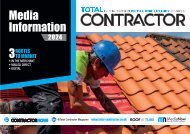January 2020
You also want an ePaper? Increase the reach of your titles
YUMPU automatically turns print PDFs into web optimized ePapers that Google loves.
building. That dutyholder will be responsible for
initiating, overseeing and influencing activity
throughout the procurement, design and
construction of a building. The key roles for
prioritising building safety will be the same as
those identified in the Construction Design and
Management (CDM) Regulations 2015 to avoid
confusion.
3. Three ‘gateways’, the first two relating to the
above and the third that the JCA is satisfied that
the signed-off design has been followed before
occupation can start.
4. More rigorous enforcement powers including
wider & more flexible powers to focus incentives
on the creation of reliably safe buildings from the
outset. Stronger enforcement powers aligned with
the Health and Safety at Work Act, and powers to
issue improvement and prohibition notices, as
well as clear powers to require changes to work
that meet Building Regulations. Time limits for
bringing prosecutions could be increased for
“major deficiencies”.
5. Higher competence levels including more
effective leadership for ensuring building safety
among key roles including an overarching body to
provide oversight of competence requirements.
The aim is to move towards a system where
ownership of technical guidance rests with the
industry as the intelligent lead in delivering
building safety.
6. More effective product testing that is clearer,
more transparent and
provides a more effective
specification and testing
regime of construction
products, including products
as they are put together as
part of a system. There
should be clear statements
on what systems products
can and cannot be used for,
with their use made
essential. The scope of
testing, the application of
products in systems, and the
“2020 will see wide ranging changes to
the regulatory and compliance requirements
placed on roofing materials manufacturers
and roofing contractors”
resulting implications must be more clearly
communicated in plan, consistent and nontechnical
information.
7. Better information through four “key
information products” integral to oversight on
building safety. They are: the digital record, the
fire and emergency file, full plans, and the
construction control plan. Hackitt recommends
that the creation, maintenance and handover of
relevant information should be an “integral part”
of the legal responsibilities of clients, principal
designers, and principal contractors undertaking
works.
8. Better procurement through the principal
contractor and client devising contracts that
specifically state that safety requirements must
not be compromised for cost reduction. Tenders
should set out how the proposed solution will
produce safe building outcomes. Contracting
documentation relating to the safety aspects of
the building should be included in the digital
record.
Carbon reduction targets
Carbon reduction targets are being focused on
through a consultation which sets out the
Government’s plans for the Future Homes
Standard, which includes
proposed options to increase
the energy efficiency
requirements for new homes
in 2020. The Future Homes
Standard will require new
build homes to be futureproofed
with low carbon
heating and world-leading
levels of energy efficiency,
and whilst the formal
introduction will be before
2025, some developers will
seek to implement the requirements ahead of
legislation. The Future Homes Standard is
currently out for consultation until 7th February
2020.
Roofing specific
The Liquid Roofing and Waterproofing Association
(LRWA) – of which QI are members – will be
issuing Technical Guidance Notes covering the BS
6229:2018 update related to Inverted Roof
construction, Water Flow Reducing layer
installation and Blue Roof guidance. Additionally,
CIRIA (Construction Industry Research and
Information Association) will be starting work
on detailed technical guidance for Blue Roof
construction and the Green Roof Organisation
(GRO) will be forming as a Trade Association
and issuing an updated Green Roof Code of
Best Practice and other guidance
documentation.
At Quantum Insulation (QI), we see ourselves as
more than just specialists in the supply of
insulation for flat roofing contractors. We see our
responsibility as being greater than that. As your
flat roof insulation supply partners, our role is to
ensure you have the right product for each and
every application that you comply with the
regulatory requirements as they are today, and
that you are aware of the possible future impacts
regulation changes may have to your business.
We are here to support your professional
development, not just to sell you the insulation
product we happen to have in stock.
For more information about our products, contact
us on the details below:
Contact Quantum Insulation
01858 456018
www.quantuminsulation.com
JANUARY 2020 TC 35

















